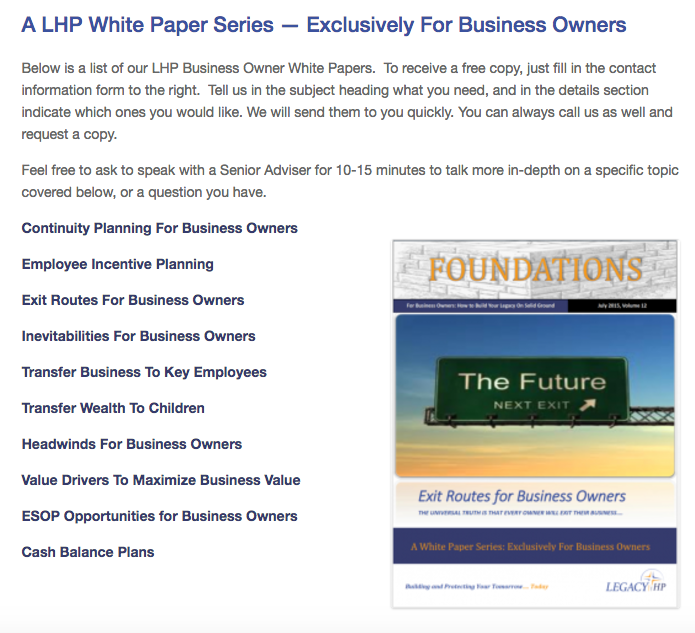"Oldco/Newco" is designed to avoid ongoing business operational liability, minimize tax consequences on a sale of business assets, and redirect business cash flow. This is accomplished by:
- Separating future business liability and risk from valuable existing business assets by creating a new entity ("Newco") to continue business operations.
- Minimizing taxation on the transfer of valuable assets by creating a new business using assets leased from the original company, rather than creating a tax consequence by transferring ownership of goodwill and other assets from the existing business to new ownership.
- Transferring or concentrating cash flow to the owners of one of the two entities – either "Oldco" or "Newco."
The most common use of the "Oldco/Newco" concept is in family business transfers. In the family run business scenario, "Oldco/Newco" may work well if the situation does not lend itself to gifting, either outright or indirectly, by using a Grantor Retained Annuity Trust (GRAT). GRATs do not work effectively to transfer ownership interests when there is substantial value, but the business is not growing in value or does not have significant income. Lifetime gifting without using some type of a split interest trust, such as a GRAT or an Intentionally Defective Grantor Trust (IDGT), can quickly exhaust available gift tax exemptions and create unwanted taxation. In these instances, "Oldco/Newco" can be the best strategy because it can allow your children to own and run the business operations, without having to immediately pay for the hard assets. As with any Exit Plan, though, it is important to use the appropriate tax and valuation professionals to correctly structure an "Oldco/Newco" strategy.
The "Oldco/Newco" concept also is a great option for owners when the liability exposure of their business operations is significant. Typically, this is a favorable strategy for businesses like construction general contractors, architecture firms, manufacturing companies and home builders. The concept also can be advantageous when business owners want to maintain ongoing management involvement and have the ability to exercise a considerable degree of control over the business operations until they are satisfied that the business can continue without their involvement.
Let’s take a look at how one business owner used the "Oldco/Newco" concept when transferring a forklift company to his children.
After reviewing the Seven Step Exit Planning Process™, the business owner determined that his main exit objective was to transfer his business to his children over the next five to seven years. He did not want to gift the business to the children, but he was willing to receive the value of the assets (approximately two million dollars) over that time frame. One of the owner’s major concerns was that he wanted to limit his liability exposure from the business as it was transferred to his children and as they assumed more operational control. He also wanted to maintain ongoing management involvement during the transition period, since it would take time to properly train his children to successfully run the forklift business.
Under these circumstances, the owner’s Exit Planning Advisors recommended that the business owner create a new company ("Newco") to be owned by his children. "Newco" hired all of the employees from "Oldco" and began paying rent to the "Oldco" company. "Newco" sold the forklifts owned by "Oldco" under an assignment agreement, giving "Newco" the nonexclusive right to sell the forklifts. Each time "Newco" sold a forklift, it paid "Oldco" the cost of the forklift, plus a pre-determined profit. "Newco" retained the bulk of the profits and, after paying the costs of sale and a moderate salary to the children, invested the profits in buying new forklifts. Over the five to seven year period, "Newco" accumulated sufficient equity so that it could secure bank financing to buy the balance of the forklift inventory from "Oldco."
The "Oldco/Newco" concept was a good strategy for this forklift business owner because it allowed him to receive payment from "Newco" and gradually liquidate the inventory from "Oldco" by selling the forklifts via the children’s company. Since the entity structure was designed with the liability being "Newco’s" responsibility, "Oldco" and the owner were not exposed to liability issues if the children happened to fail in the business.
As seen in this example, "Oldco/Newco" can be a great solution for family business transfers. If you have any questions about how this strategy applies to your company, please contact me.
Take care and have a good day,
Michael
ABOUT LEGACYHP: Our passion is our mission -- To position our clients into a positive, energized, posture -- within your businesses and within your lives -- So that you manage change confidently, take decisive action, and enjoy life's journey Today... while you enjoy building your Legacy for Tomorrow.
Notice: The information contained in this article is general in nature and is not legal, tax or financial advice. For information regarding your particular situation, contact an attorney or a tax or financial advisor. The information in this newsletter is provided with the understanding that it does not render legal, accounting, tax or financial advice. In specific cases, clients should consult their legal, accounting, tax or financial advisor. This article is not intended to give advice or to represent our firm as being qualified to give advice in all areas of professional services. Exit Planning is a discipline that typically requires the collaboration of multiple professional advisors. To the extent that our firm does not have the expertise required on a particular matter, we will always work closely with you to help you gain access to the resources and professional advice that you need.



